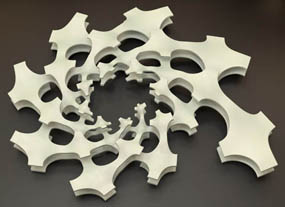 |
 |
 |
 |
 |
 |
 |
|
|
 |
|
|
 |
|
|
9. Helical Hole Surfaces
9.1. Black/White Tilings. In Figures 42a – 42e we have shown that helical hole surfaces can be created starting with a checkerboard tiling. And in Chapter 4 we have seen that also some of the regular and semi regular polyhedra can be colored in a checkerboard fashion. So when we use the same steps as in section 8.1, but now starting with the icosidodecahedron (Figure 45), we can create the spherical helical hole surface shown in Figure 46. Note that this is a single surface structure. In Figure 47 we can see another example of a spherical helical hole surface. This one is based on the cuboctahedron.
|
|
|
 |
|
|
 |
|
 |
|
 |
|
|
|
Figure 45: Icosidodecahedron
|
Figure 46: Helical Hole Surface
|
Figure 47: Base: Cuboctahedron
|
|
|
9.2. Cylindrical Tilings. Also cylinders can be covered with a black/white tiling. In Figure 48 and Figure 50 we can see two basically different coverings of the cylinder. In Figure 50 the covering is made in a helical way. Both coverings can be used to create a helical hole surface (Figure 49 and 51). |
|
|
 |
|
 |
|
|
Figure 48: Cylinder
|
Figure 49: Helical Hole Surface
|
|
 |
 |
|
|
Figure 50: Helical covering
|
Figure 51: Helical Hole Surface
|
|
| Both the spherical and the cylindrical helical hole surface can be interwoven with copies of itself (see Section 7.2). Those copies however have to be a scaled version of the original surface. We can solve this by starting with a cone instead of a cylinder. In that case the scaling is introduced in the black/white tiling. And therefore we can create a helical hole surface of which a copy will fit in the empty space of the original surface. |
|
| 9.3. Fibonacci Tilings. There is also a way to introduce the scaling of the tiles in a flat tiling. For that we have to look at patterns that are based on the Fibonacci numbers. When we use the logarithmic spiral which is related to the Fibonacci numbers, we can create tilings in which each tile is a scaled copy of any of the other tiles. All tiles have the same shape but not the same size. These so called Fibonacci tilings can also be found in nature. A well known example is the pattern of the seeds in a sun flower. The net of such a tiling is the intersection of two sets of logarithmic spirals. If we choose the right combination of the number of spirals in each of those sets we can get a tiling that can be colored in a checkerboard fashion. In the example in Figure 52 there are 7 spirals in one set and 9 spirals the other. Based on this tiling we can construct an helical hole surface. |
|
 |
|
 |
|
|
|
Figure 52: Fibonacci Tiling
|
Figure 53: Spiral Helical Hole Surface
|
|
| And now we have got a spiral helical hole surface (Figure 53) that can be interwoven with an exact copy of itself. |
|
10. Conclusion
10.1. Weaving and Helical Hole Surfaces. In architecture most of the ideas for constructions are based on nature. Weaving is invention of mankind and a lot of possibilities are still to be discovered. The discovery of the spiral hole surfaces leads to organic looking structures based on patterns that we know from nature. In a way it brings us back to the question: Does nature weave? The 3D weave structures of Kenneth Snelson have inspired me very much. This is my attempt to explore this a little further. I realize it is just a start.
|
|
References
[1] Grünbaum and Shephard, Tilings and Patterns, W.H. Freeman and Company, New York, 1987.
[2] http://en.wikipedia.org/wiki/Conway_polyhedron_notation
[3] Alan Holden, Orderly Tangles, Columbia University Press, New York, 1983.
[4] Rinus Roelofs, Connected Holes, in Bridges Leeuwarden Proceedings, 2008
[5] Kenneth Snelson, Weaving, Mother of Tensegrity, www.kennethsnelson.net
|
|
|
|
|
|
|
|
|
|
|
|
|
|
|
|
|
|
|
|
|
|








